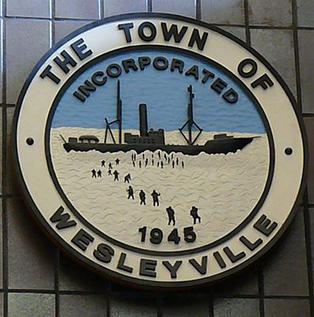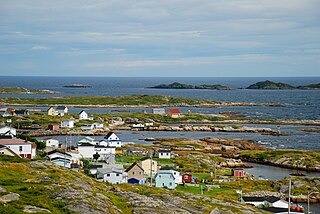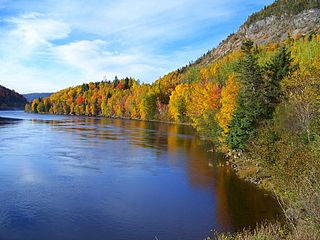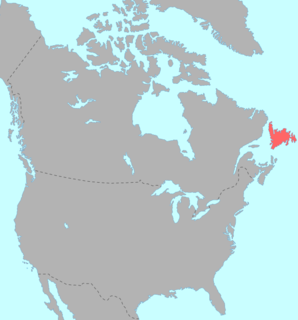Newtown is a part of the Municipality of New-Wes-Valley, located at the North end of Bonavista Bay in the province of Newfoundland and Labrador, Canada. The approximate population is 400. Settlement in Newtown originated around 1850 when people relocated from nearby areas. Newtown is well known for being built on many small islands, and is the home of the Barbour Living Heritage Village.

Wesleyville is a small coastal community in Newfoundland and Labrador, Canada. It is located on the Straight Shore of Bonavista Bay, on the northeast coast of Newfoundland, near the communities of Greenspond and Newtown. It was settled in the early 19th century, when residents relocated from nearby islands.

Greenspond is a community in the province of Newfoundland and Labrador, Canada.
Safe Harbour is an abandoned outport on the northeast coast of Newfoundland in the Canadian province of Newfoundland and Labrador. It is now a part of the town of New-Wes-Valley.
Templeman, Newfoundland is located on the north side of Bonavista Bay just south of Cape Freels and north of Wesleyville. Templeman has a shallow and rocky harbour, therefore its harbour can only accommodate and is only suitable for small boats.
Valleyfield, Newfoundland is a village and was served by the C.N.R. It joined the Rural District of Badger's Quay-Valleyfield-Pool's Island in April 1980 until 1992 when the District merged with other nearby towns to form New-Wes-Valley. Valleyfield has a good harbour, and is the location of the Beothic Fisheries fish plant.

The 1st Newfoundland general election came after many years of agitation against the British Parliament. Newfoundland was the last British colony in North America to gain representative government.
Musgrave Harbour is a Canadian town in the province of Newfoundland and Labrador.
Cape Island is the name of both an island and a community in the Canadian province of Newfoundland and Labrador.
Deadman's Bay, Newfoundland is located on the "Straight Shore" of Bonavista Bay near the community of Lumsden. The community is located near excellent fishing grounds, contributing to its diversified and successful fishery despite its exposed, sandy coastline and harsh fall storms.
Indian Bay is located in Newfoundland, Canada.
Flower's Island is one of the communities that comprise an area on the northeast coast of the Island of Newfoundland, called Bonavista North. These communities have a shared history in that they were settled by people from England, predominantly from the West Country—Dorset, Devon Somerset and Hampshire.
Pool's Island is an incorporated community of Badger's Quay-Valleyfield-Pool's Island in the province of Newfoundland and Labrador, Canada. It is now part of the town of New-Wes-Valley.

Fair Island, also called Vere Island, is one of the communities that comprise an area on the northeast coast of the Island of Newfoundland, called Bonavista North. These communities have a shared history in that they were settled by people from England, predominantly from the West Country - Dorset, Devon Somerset and Hampshire.
Swain's Island, Newfoundland, is actually a group of eight islands on the north side of Bonavista Bay, southeast of Wesleyville. All of these islands once had inhabitants but eventually all of them were resettled, mostly to Wesleyville.
Located on the northwest side of Bonavista Bay, Newfoundland at the mouth of the Indian Bay inlet is a small island named Silver Fox Island that was once inhabited. It is about 3 km in length and about 3 km from Fair Island. The first settling began at Warren's Harbour on the southern side of the island.
Pinchard's Island is one of the communities that comprise an area on the northeast coast of the Island of Newfoundland, called Bonavista North. These communities have a shared history in that they were settled by people from England, predominantly from the West Country - Dorset, Devon Somerset and Hampshire.
Naboth Winsor was born to Robert Stewart Winsor and Jane (Butt) Winsor, on Winsor's Island, one of the islands comprising Swain's Island, Bonavista Bay, Newfoundland. Winsor and his family moved to nearby Wesleyville when he was four years old. Winsor received a Bachelor of Arts Degree, the Degree of Master of Divinity, and a Master of Arts Degree. He was an Ordained United Church Minister, and later, an author. Winsor was a United Church Minister for forty-four years, and he wrote several books on certain aspects of Newfoundland History, primarily on areas in Bonavista Bay, Newfoundland.
Robert Dyer left the village of Heytesbury, in the county of Wiltshire, England, to voyage across the Atlantic Ocean to serve as a Newfoundland School Society teacher in the fishing community of Greenspond, Newfoundland. The Newfoundland School Society was established by the English merchant, Samuel Codner, who realised the need for educating the poor population of Newfoundland, and other poor colonies in British North America as well. Dyer first arrived in Newfoundland in 1839 and began his career as a teacher. He stayed in Greenspond for twenty years, earning the respect and admiration of the inhabitants and those who met or worked with him. Dyer was also ordained a Church of England Deacon in 1849; therefore, his work in Greenspond consisted of both teaching and ministerial duties. Dyer and his family later moved to Alberton, Prince Edward Island, where he was a minister in a Church of England Parish.







